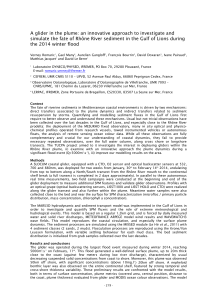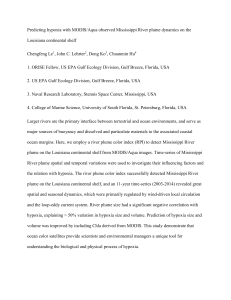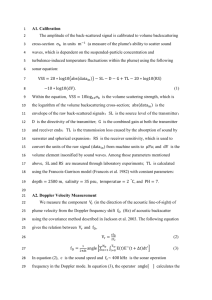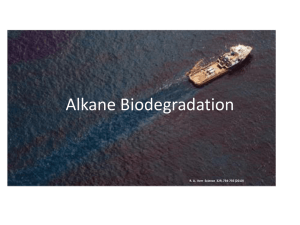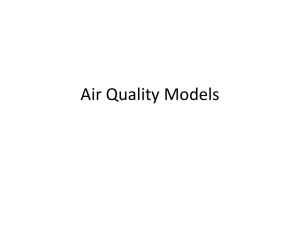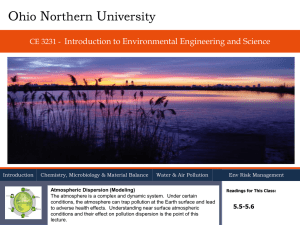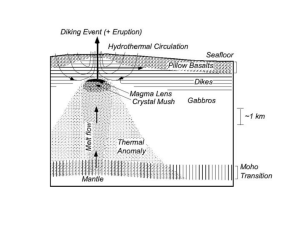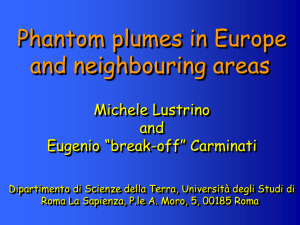Lab4_PLUME
advertisement
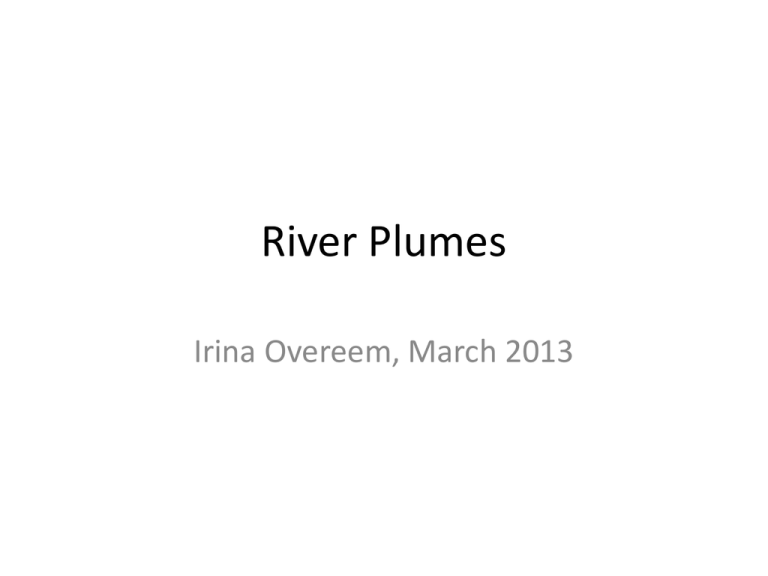
River Plumes Irina Overeem, March 2013 What is a River Plume? Greenlandic River Plume, July 2010 Cass River Plume, NZ Eel River Plume, CA 1974 flood Concept of a Plume After: Albertson, M.L., Dai, Y.B., Jensen, R.A., Hunter, R., 1950, Diffusion of submerged jets. American Society Civil Engineers Trans, v. 115, p. 639-697. Hypopycnal Plume •Steady 2D advection-diffusion equation: ¶uI ¶vI ¶ æ ¶I ö ¶ æ ¶I ö + + lI = çK ÷+ çK ÷ ¶x ¶y ¶y è ¶y ø ¶x è ¶x ø where: x, y are coordinate directions u, v are velocities K is turbulent sediment diffusivity / eddy diffusivity I is sediment inventory λ is the first-order removal rate constant Albertson, M.L., Dai, Y.B., Jensen, R.A., Hunter, R., 1950, Diffusion of submerged jets. American Society Civil Engineers Trans, v. 115, p. 639-697. 4 Steady 2D advection-diffusion equation: ¶uI ¶vI ¶ æ ¶I ö ¶ æ ¶I ö + + lI = çK ÷+ çK ÷ ¶x ¶y ¶y è ¶y ø ¶x è ¶x ø where: x, y are coordinate directions (m) u, v are velocities (m/s) K is turbulent sediment diffusivity (m2/s) I is sediment inventory (kg/m2) λ is defined per grainsize, it is the removal rate constant (1/s). This is also often called the settling rate. Simple Plume Experiment Plume Deposition basecase for Greenland Fjord 0.11 0.1 285 0.09 290 0.08 0.07 295 0.06 300 0.05 305 0.04 0.03 310 0.02 315 0.01 320 10 20 30 40 50 60 70 80 90 100 Simple Plume Experiment Simple 1000 year 2D SedFlux experiment of 1000 year duration - generic bathymetric profile (at 80 km, -120m waterdepth, dropping to 300m) - stable sediment input and water discharge - slow sea level rise River mouth dependent deposition Simple 1000 year Sedflux experiment with stable sediment input and slow sea level rise, stable total daily discharge: Wide River scenario: width = 750m, depth=1.66m Narrow River scenario: width = 125 m, depth =10m River velocity dependent deposition Simple 1000 year 2D SedFlux experiment with stable sediment input and slow sea level rise, stable total daily discharge: Fast Plume scenario: u0 = 1.2 m/sec Slow Plume scenario: u0 = 0.8 m/sec Plume examples River Mouth Angle = 15 º River Mouth Angle = 45 º 10 External factors influencing plumes The shape that a hypopycnal plume will have, depends on a variety of factors: Coriolis effect •Angle between the river course at the entry point and the coastline. •Strength and direction of the coastal current. •Wind direction and its influence on local upwelling or downwelling conditions. •Mixing (tidal or storm) energy near the river mouth. •Latitude of the river mouth and thus the strength of the Coriolis effect. Curved plumes References • Albertson, M.L., Dai, Y.B., Jensen, R.A., Hunter, R., 1950, Diffusion of submerged jets. American Society Civil Engineers Trans, v. 115, p. 639697. • Bates, C.C., 1953, Rational theory of delta formation. AAPG Bulletin, v. 37, p. 2119-2162. • Syvitski, J.P.M., Skene, K.I., Nicholson-Murray, K., Morehead, M., 1998a, PLUME 1.1; deposition of sediment from a fluvial plume. Computers & Geosciences, v. 24, 2, p. 159-171. • Nemec, W., 1995, The dynamics of deltaic suspension plumes In: Oti, M.N., Postma, G.(eds.). Geology of deltas, Balkema, Rotterdam, The Netherlands. p. 31-93. • Overeem, I., Syvitski, J.P.M., Hutton, E.W.H., (2005). Three-dimensional numerical modeling of deltas. SEPM Spec. Issue, 83. ‘River Deltas: concepts, models and examples’. p.13-30.


